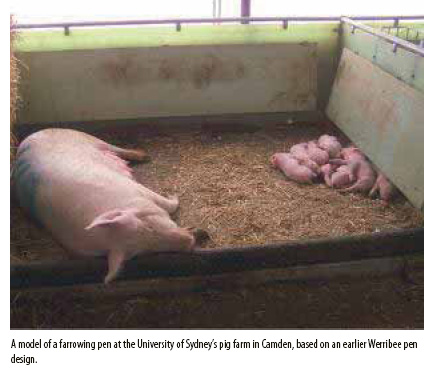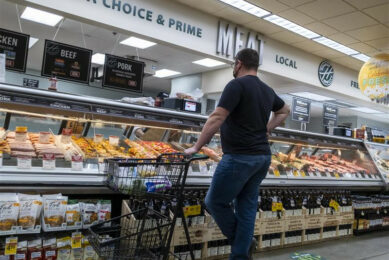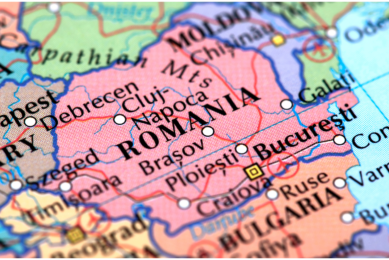Pig welfare: A contentious issue for Australia’s farmers

What have animal rights groups, state government politics and a battle for market supremacy between two giant retail chains got to do with the issue of welfare in the Australian pig industry? Far too much, would probably be the answer if you asked a typical Australian pig farmer.
As in many developed economies, the disconnection between consumers and the farmers who grow their food is a root cause of many problems for the Australian intensive livestock sector and pig farmers in particular.
A largely urban based population with little understanding of modern farming methods that deliver their safe, nutritious and affordable food have become fertile ground for animal activist groups. These activist groups are well organised, well funded and know how to use modern media to get their message across.
The focus of their attack a couple of years ago was sow stalls and inevitably, as the issue attracted mainstream media attention, it was not long before some politicians leapt on the bandwagon to push their own agenda.
In Australia, livestock farming methods’ regulation is in general a state government issue. In Tasmania, the smallest state, with a population of just over half a million or 2.5% of the total national head count and very few commercial pig farms, the government exists as a leftish coalition of green and labour politicians. In June 2010, this government decided to ban sow stalls effective 2014.
Unnecessary
It was a somewhat unnecessary move as the pig industry in Australia had already accepted the need to change sow-housing methods by 2017 in a nationwide agreement negotiated with the Primary Industries Ministerial Council back in 2007. This body attempts to establish some uniformity of regulation in primary industries across various legislative bodies within Australia and New Zealand.
The Model Code of Practice for pigs stipulates that ‘the use of sow stalls be restricted to a maximum of six weeks – or until the pregnancy is confirmed, effective 2017’. Prior to the Tasmanian Government’s move, the Model Code of Practice had been generally accepted by regulators nationwide.
Enter the supermarket chains, and in particular Coles, the smaller of a duopoly in Australia where, Coles and their rival Woolworths, control over 70% of all food shopping. Woolworths is the market leader with the biggest volume and historically the highest profit margins. Coles, struggling in the shadow of Woolworths, was acquired in mid-2007 by a large western Australian based conglomerate Wesfarmers, in a cash and share deal worth more than A$22 billion.
Despite this massive investment, Coles continued to struggle against its rival and in May 2008 engaged the services of Ian McLeod, a retail specialist who held senior roles in the Asda supermarket business in the UK.
McLeod and his merchandise manager John Durkan, who joined Coles at about the same time, faced a big task in reducing rival Woolworth’s long held dominance.
Amongst their strategies to claw back sales volume, Coles followed the Tasmanian governments lead by stipulating that its meat supplies, including the fresh pork sold in its stores should be raised in ‘welfare friendly’ systems. One initiative announced in July 2010 was the requirement of sow stall free suppliers, effective 2014.
Free-range
The company also sought to increase its offering of what it considered itsconsumers favoured in pig rearing methods, typically free-range systems. This move infuriated the mainstream Australian pig industry as although fresh pork is only supplied from within Australia, up to 72% of pork consumed as a processed product, ham, bacon, etc. (which represents up to 60% of the overall market) is imported.
Countries supplying frozen pork for further processing are Denmark, Canada and the US where, unlike Australia pig farmers, producers benefit from various levels of subsidies; further the great majority of imported pork is supplied from sources that do not comply with the sow housing conditions that were expected by Coles when it announced its initiative concerning Australian fresh pork suppliers.All of the above concerns pig welfare as a consumer and by extension, a retailer.
In the long run the pork industry’s relationship with its major customers like Coles and Woolworths have been mutually beneficial and this latest controversy, which centres largely on sow housing will, as in the past, be resolved.
While Coles management, shortly after the sow stalls removal by 2014 conditions were announced, reckoned that its fresh pork sales had increased as a result of consumer support for the ‘welfare-based’ initiative, there is little independent evidence of welfare being the cause of any changes in sales.
A recently completed Stollznow study suggests that any impact was likely to be small, given that in 2010 only 17% of Australians rated animal welfare as a highly important consideration when buying meat.
Also, based on Nielsen Homescan panel information, whilst Coles did slightly outperform market growth in fresh pork sales for the month from mid June to July in 2010, they grew slightly slower in the month before and the month after that period.
Australian Pork Limited (APL) general manager marketing, Peter Haydon, recently released results of a consumer survey relating to pork which revealed that out of nine key considerations, taste was number one (85.6%) and animal welfare last, see Figure 1.
Also the same survey conducted in 2009 and 2010 revealed a fall of animal welfare concern from 60% in 2009 to 52.3% in 2010, see Figure 2.
Consumer concerns
Just because consumer concerns are not as high as animal welfare groups would suggest, and big retailers suggest, does not mean that the Australian pig industry as well as associated professional and academic groups ignore the issue – far from it.
At the time of the Tasmanian Government’s and subsequent Coles’ initiative on sow stall removal, the Australian Veterinary Association (AVA) released a statement on the issue. Dr Tony Fahy, president of Australian pig veterinarians, said: “AVA’s pig veterinarians think that these recent developments could be a concern for the welfare of pigs. The impact on welfare could be unacceptable if we don’t put pigs in a correctly designed group housing system, supervised by competent stock people. I’ve seen some good systems and others where the injury and resulting culling rates are unacceptably high,” he said.Dr Fahy continued to say, “There is insufficient research data available at the present time to allow us to accurately define minimum standards for housing pregnant sows. The AVA is currently working toward defining a minimum standard in collaboration with the Royal Society for the Protection of Animals (RSPCA) and APL.”
Sow confinement
Given all the media attention sow confinement has received in Australia, those not associated with the industry might think that it is the sole issue surrounding pig welfare and that there has been little research into alternative housing systems.
There are other welfare issues and during the last 25 years or so, plenty of valuable work has been conducted both within commercial production and at the highest levels of animal science establishments.
Boar taint, for instance, is both a consumer and an animal welfare issue.
Australia is one of the few countries that does not routinely castrate all male pigs. APL states that, in some situations, castration is a necessary management practice for production to avoid boar taint.
New technologies, such as the use of Improvac, are enabling farmers to avoid physical castration in some situations through the use of a vaccination against boar taint. Pigs that are not castrated are sent to market before they reach sexual maturity. About 35% of current production in Australia has adopted vaccination against boar taint in their production systems.
Alternative Farrowing Systems
Addressing the concerns of industry professionals as well as consumers, retailers and of equal importance producers, the Animal Welfare Science Centre (AWSC) held a seminar in September 2010, in Melbourne, Australia, called ‘Alternative Farrowing Systems, identifying the gaps in knowledge’.AWSC consists of four collaborative partners being the relevant animal and veterinary science faculties from Melbourne University, Monash University DPI Victoria and the Ohio State University (USA) with key links to University of Queensland and Massey University in New Zealand.
AWSC conducts research into welfare methodology and strategies to measure animal welfare.
Speakers at the seminar included the director of AWSC, Paul Hemsworth, Greg Cronin, University of Sydney and Hugh Payne from the Department of Agriculture and Food, Western Australia.
In 2010, a research collaboration between associate professor Inger Lise Andersen and professor Knut Bøe from the University of Life Sciences (Norway) and Dr Cronin, constructed four prototype farrowing pens at the University of Sydney’s Mayfarm pig unit in Camden, New South Wales. These pens were designed by Dr Andersen based on Dr Cronin’s work conducted with his earlier designed ‘Werribee’ farrowing pen.
Rebecca Morrison, research scientist at Rivalea (Australia), the country’s largest integrated pork producer, conducted her PhD with Hemsworth and Cronin. “Rivalea Australia is a leader in the industry in terms of researching and investigating non-crated farrowing systems,” she said. One of the most critical initiatives as far as pig welfare is concerned is the research about to commence in July.
Programme 1 of six specific research programmes is all about enhancing animal welfare and applies to sows in lactation, gestation and their progeny,” said Dr Roger Campbell, CEO of the Pork CRC.
“We need to look at systems and strategies that genuinely and cost effectively enhance the well being of both sow and progeny: some real innovation will be required and we do not just want to repeat what has been done previously. We have some of the best Australian and internationally recognised scientists involved and collaboration from the North American Universities of Alberta, Ohio, Iowa State and INRA in France.”Campbell said, “Research will cover three core areas, mating and lactation innovations, ‘gradual’ weaning systems, and management of weaned sows in groups. As part of our expert programme, we will work closely with the RSPCA and retailers Woolworths to develop R&D, education and utilisation projects for Programme 1. The new Pork CRC is very serious in its plans to enhance sow/piglet welfare and it is hoped that progress in this regard will deliver a competitive advantage, not only in domestic markets but internationally.”
“Also the programme has the potential to put pressure on imports assuming that the major retailers and consumers are serious about wanting improved sow welfare. The timing of this research fits in well with the Australian pork industry’s decision to phase out gestation stalls by 2017. Approximately 30% of the Pork CRC budget over the next eight years will be allocated to the confinement- free sow and piglet management (Programme 1),” Campbell concluded.











